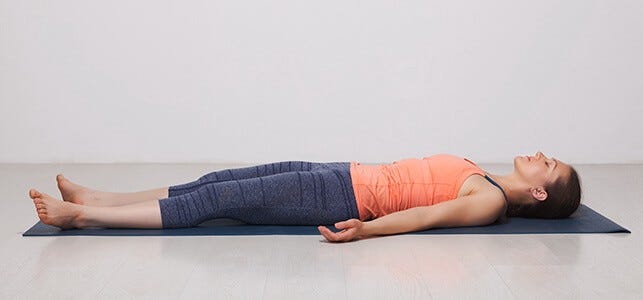Can You Meditate Lying Down? The Real Truth About a Misunderstood Concept

“Can I meditate lying down?” is a question I’ve seen floating around the web for some time now. It seems that while meditation has apparent benefits, people just don’t want to sit and do it.
From a purist point of view, yes meditation can be done lying down. But as with most cases, the purist point of view is not enough. Reality is simply not that black and white.
You see, meditation is a balance between relaxation and focus. You need to be good at concentration to meditate deeply. Yet, when that concentration becomes too intense, it leads to stress and pulls you back to waking consciousness.
This is where deep relaxation comes into the picture. By having a “relaxed concentration” you can meditate without being uncomfortable or too sleepy.
A sitting meditation position provides the best balance between relaxation and concentration. There’s no compulsion to sit cross-legged on the floor. You can use a chair, a meditation bench, and as many cushions as you want.
Whatever you do, sitting comes out to be the optimal position for meditation. Unlike trying to meditate while standing up, there’s a certain degree of relaxation when you sit. On the other end of the spectrum, you’re more alert than if you try to meditate lying down. Most people simply dose off to sleep when they lie down.
The key here is the spine. Keep the spine straight and maintaining an upright posture is the single most important aspect of any meditation postures.
Generally speaking, sitting is always preferable to lying. The one exception is if you find yourself in too much pain or discomfort to sit. In these situations, of course, it is OK to lie flat on the floor as an alternative.
Is Savasana (Corpse Pose) Meditation?
In case you’re not familiar with Savasana, here’s what it looks like:
 chopra.com
chopra.com
It’s usually practiced at the end of a yoga session to relax the body and energize every part of the body equally. There’s great confusion between deep relaxation in Savasana and true meditation, which should be done in a seated position with the spine erect.
Many blogs and teachers teach meditation in a supine position. But it’s not “meditation” in the whole sense of the practice. It’s simply deep relaxation. Let me tell you why it’s not really meditation.
The singular, universal goal of meditation is to raise energy up the spine and make its way to the brain. This is only possible when your spine is straight. When you lie down, the energy flows to all parts of the body — your legs, hand, feet, middle-body, etc. It’s then impossible to get the energy to only move up — no matter how much you visualize it.
Some lying-down meditators say, “But I’m not going to sleep! I’m in a whole another place.” Yes, there’s a name for that place — subconsciousness. But the aim of meditation is to reach the superconscious state.
When we start out meditation, we don’t really know what stillness and superconsciousness feel like. And so anything that draws our awareness out of the material world feels “right.” Yet, there’s a huge difference. You can draw your energy from the world and stop your thoughts by going to sleep as well.
But that’s not meditation, is it? So it is, that when people feel good while lying down, they think they’re “meditating,” but they’re not. Occasionally, you might go to sleep and wake up feeling refreshed. That’s fine — maybe your body needed rest. Nonetheless, don’t think you meditated.
Mindfulness Is a Different Thing
You can’t “meditate” lying down, but can you be mindful? Yes, you can! In fact, we can (and should) be mindful of everything by bringing non-judgmental awareness to our actions.
In that sense, yes, you can practice being mindful of your body while lying down. The simplest way to do that is Savasana. Here’s how you practice it.
Lie down on a flat surface, palms facing upwards. Now, practice 2–3 rounds of tensing and relaxation. Breathe in, tense your whole body and then relax gently. Do not shock your system by rapid tensing and relaxing. Feel the energy flowing to all the parts of your body.
Once you’ve done this, be very still and take deep breaths. Notice the air through your nostrils and observe your belly moving in and out. Let the breath be natural, don’t restrict it. Feel deeper relaxation with each exhalation.
Imagine the space entering your body through your feet. Moving towards your calves, knees, buttock, stomach, arms, chest, neck, and brain. Repeat this cycle and focus on each part as long as you like, leaving it completely relaxed.
Feel yourself one with space. Keep breathing deeply. Inhale positivity, exhale negativity. Inhale joy, exhale sadness. Inhale peace and calmness, exhale stress.
Free your body of all negative emotions and thoughts. Be completely present at the moment. If you feel the tension in a specific part of your body, try to relax it with even greater focus.
You can continue for as long as you want. This posture is ideal to practice before meditation and sleep. You can also practice it between various stretches/yoga postures.
And if you think I’m against the whole idea of lying down, I’m not. Here are a few benefits you’ll get when you practice Savasana:
-
Rejuvenation of the senses: By spending most of our days working and moving about, we lose touch with our bodies. By relaxing and focusing on the senses, we give them a break and get in tune with them. The senses feel more relaxed and acute than ever.
-
Eases pain and discomfort: Any form of discomfort can be alleviated if you relax into Savasana and consciously relax a body part. I’ve heard stories of a practitioner who once sprained a leg on a hike. After 20 minutes of consciously energizing her leg, she was as good as before.
-
**It promotes better sleep: **Studies show that mindfulness practices considerably help with insomnia and stress reduction. A short 5-minute meditation before bed can make or break your sleep.
Final Thought
If you want to meditate, lying down is probably not the best way to do so. While it’s good for a mindfulness session like a body scan, it doesn’t draw energy up the spine as other seated postures do.
Plus, there’s always a good chance of falling asleep and going into the subconscious instead of the superconscious state. But if sleeping soundly is your goal, by all means, it’s the best tool at your hand.
I hope this clarified some of the differences between mindfulness and meditation as well as the common confusion about lying down meditation.
Struggling to meditate? Get your free 7 Day email course — Meditation 101: How to Start Meditating